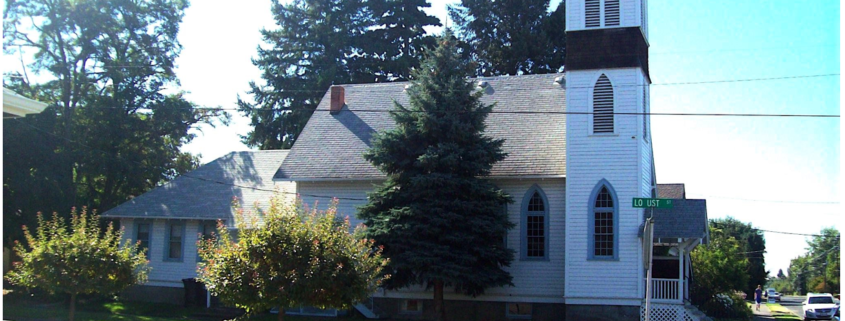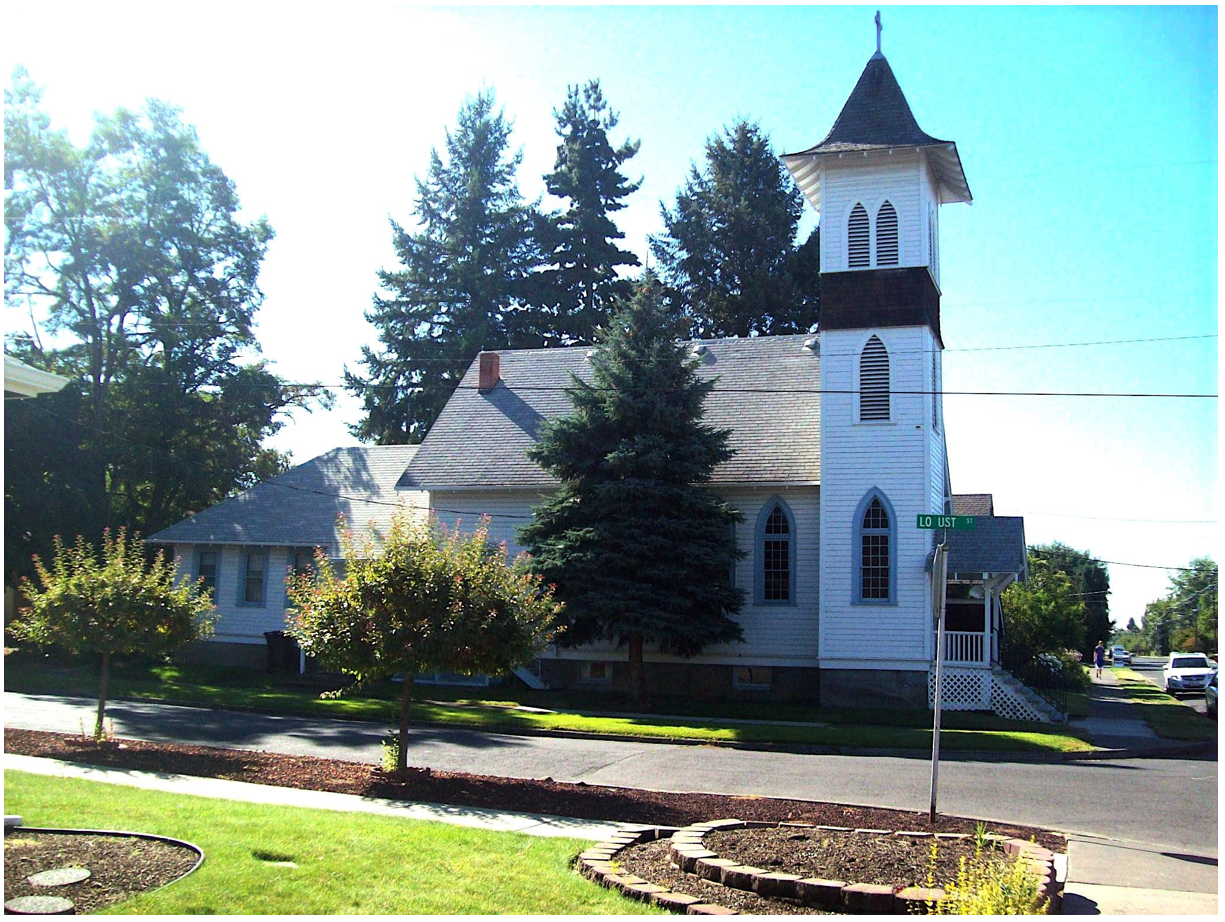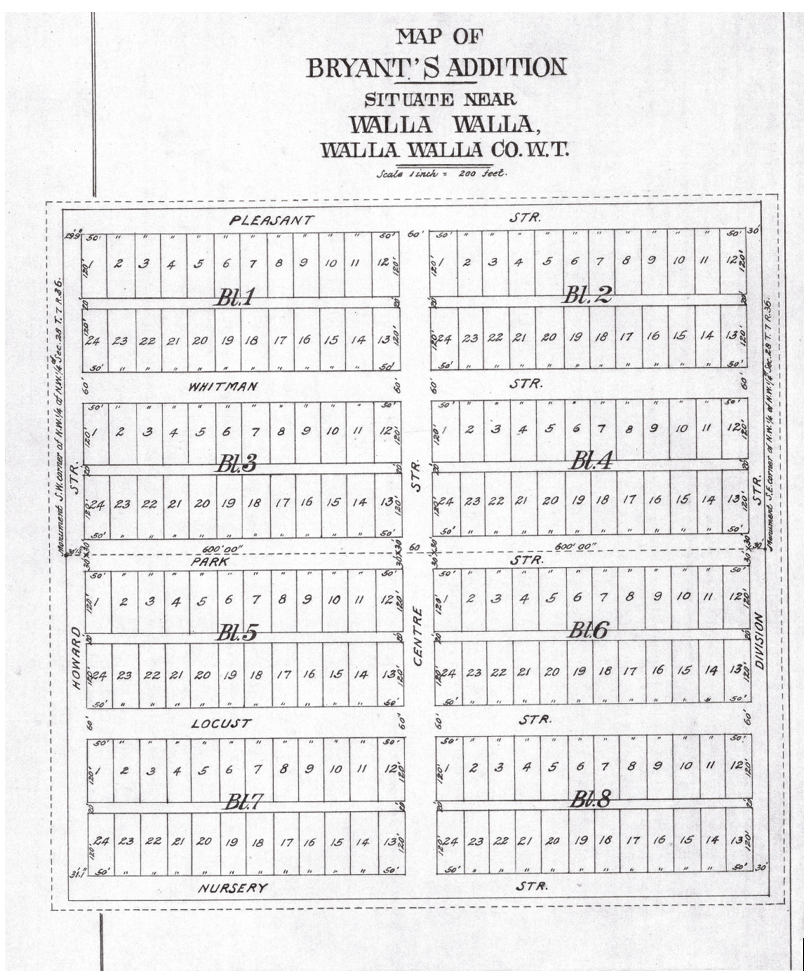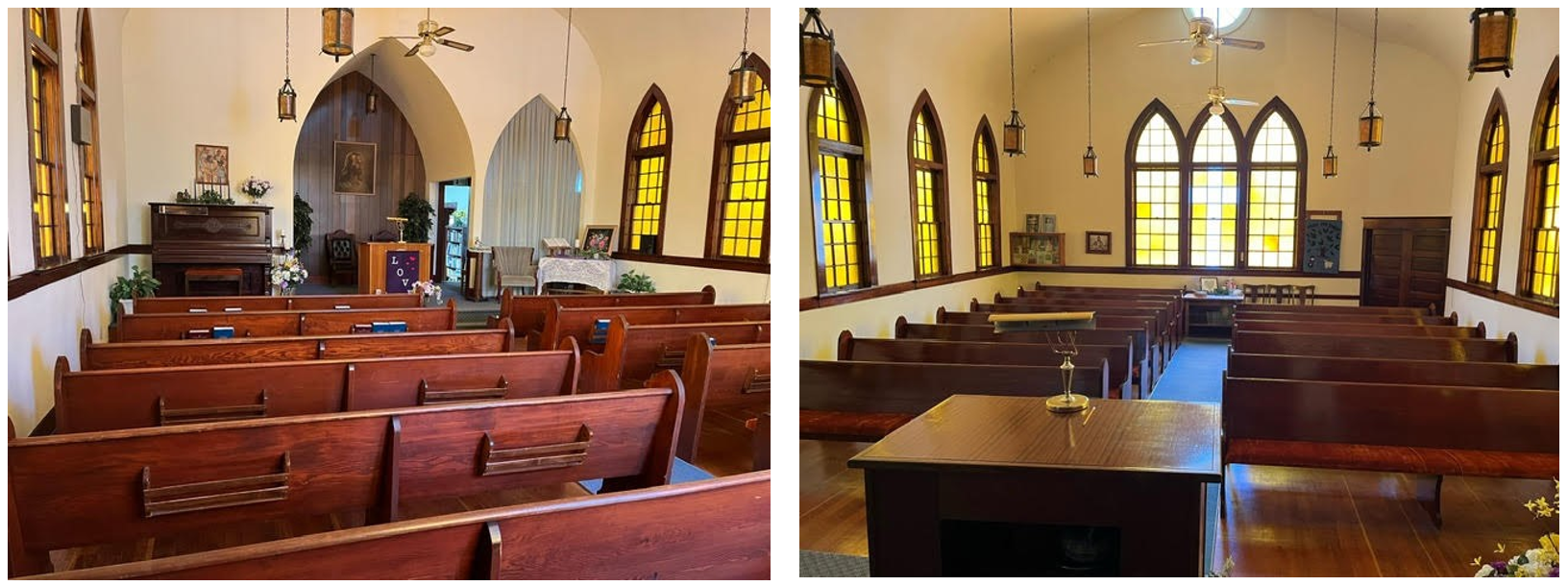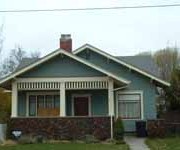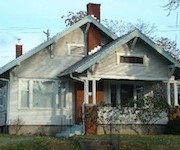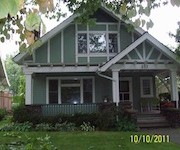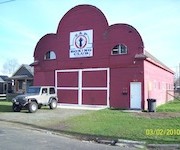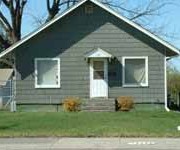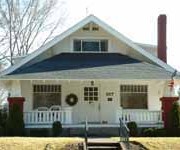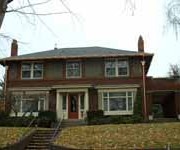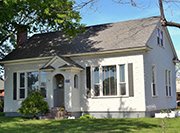History of 1001 Howard Street, Walla Walla, WA
Legal Description
Bryant’s Addition, North ½ of Lots 1 and 2, Block 7
Full Legal Description
The North half of Lots 1 and 2 in Block 7 of Bryant’s Addition to the City of Walla Walla, according to the official plat thereof of record in the office of the Auditor of Walla Walla County, Washington. Also, a strip of land 10 feet in width and 60 feet in length adjoining the above described property on the west side thereof and being a part of the vacated portion of Howard Street as vacated by the City of Walla Walla under Ordinance no. 1106.
Title and Occupant History
Washington Territory was created in 1853. In 1854, the new territorial legislature created Walla Walla County, which stretched from the crest of the Cascade Mountains to the crest of the Rocky Mountains in the present states of Washington, Idaho and Montana. In 1855, Isaac Stevens, governor of Washington Territory, held a council on the banks of Mill Creek at the present site of Walla Walla with representatives of regional Indian tribes to purchase land from them. The Yakamas, Cayuses and Walla Wallas were dissatisfied with the treaties and the intrusion by whites into their lands before the treaties’ ratification, and war followed. Missionaries, former French-Canadian employees of the Hudson Bay Company trading post at Wallula, and soldiers at the military Fort Walla Walla were the primary European occupants of the area prior to 1859, when the treaties were finally ratified and the land was opened for settlement. The transfer of ownership occurred by virtue of a treaty signed on June 9, 1855 in Walla Walla and ratified on March 8, 1859 by President James Buchanan, in which all of the land in the Walla Walla area was acquired from the Cayuse and Walla Walla Indian tribes.
The town of Walla Walla was originally laid out by County Surveyor Hamet Hubbard Case in 1859, prior to its formal incorporation as a city in 1862, as a one-quarter mile square with its eastern side centered on the point where Main Street crossed Mill Creek (at roughly the point where it does now).
The original plat was lost, probably in the fire of 1865. Thus, the earliest plat on file is one made by W. W. Johnson, City Surveyor, in July 1865 that claims to have made corrections to Case’s survey. Johnson’s survey was made the official plat of the City of Walla Walla on September 25, 1866, and was filed and recorded July 5, 1867.
On April 1, 1865, part of a U.S. Patent consisting of 40 acres was granted to Thomas Cantrill, as recorded in the Vancouver, W.T. District Land Office. The first entry in the local land records was when this area of town was platted as Bryant’s Addition and filed September 15, 1880. Bryant’s Addition is described on the plat map as the “South ½ of the Northwest ¼ of Section 28, Township 7 North, Range 30 East of the Willamette Meridian and the North ½ of the Southwest ¼ of the Northwest ¼ of the same section.” The boundaries were Howard, Pleasant, Division and what was then called Nursery Street and is now Chestnut Street.
6/25/1883, Warranty Deed, Viretta and John Bryant, grantors; Mrs. Mary Lucinger, grantee, Lots 1 and 2, Block 7, $240. Mrs. Lucinger was not listed in the 1883 city directory. In 1889, she was listed as the widow of Jacob Lucinger. The Lucingers resided at 324 South 2nd where Mary Lucinger was listed as residing as late as 1906.
6/19/1906, Ordinance, to vacate 10 feet of the Easterly side of Park Street (later renamed Howard Street) from Juniper Street to Bryant Avenue.
11/17/1906, Warranty Deed, Mrs. Mary Lucinger, a widow, grantor; J. W. Hitchcock, grantee, Lots 1 and 2, Block 7, $750. Jason Hitchcock’s first listing in a city directory did not occur until the 1909-10 edition when he both operated a grocery and resided at 30 West Walnut.
1/28/1910, Indenture, J. W. and Lillian M. Hitchcock, grantors; W. A. Pitcher, grantee, Lots 1 and 2, Block 7, $1,300. Pitcher was listed as a clerk at Catton & Buffum, wholesale produce, with residence at 609 North 8th.
2/4/1910, Deed, Estate of John Bryant, deceased, by Viretta Bryant, widow of the deceased, and Cyrus Bryant, John P. Bryant and Mandana Broughton, children of Viretta Bryant, grantors; J. W. Hitchcock, grantee, to quit claim forever and interest in Lots 1 and 2, Block 7 of Bryant’s Addition, $1.
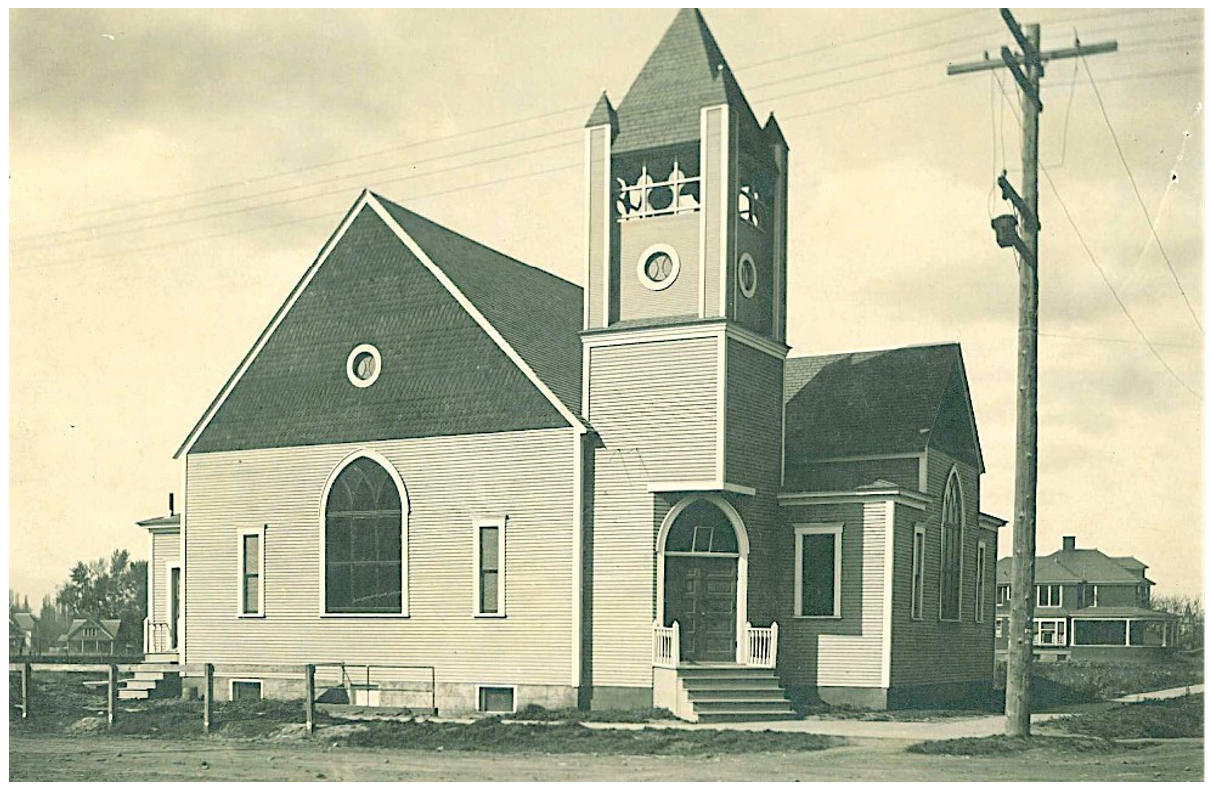
The former United Brethren Church on the southwest corner of Juniper and Howard Streets, no longer standing, where the congregation of Emmaus Evangelical Lutheran Church met pending completion of their new building. Whitman Archives photo.
10/31/1910, Deed, W. A. Pitcher, a bachelor, grantor; Emmaus Evangelical Lutheran Church, grantee, Lots 1 and 2, Block 7, $1,200. The 1909-10 city directory listed Emmaus Lutheran Church on “Juniper, sw corner Park” (now renamed Howard). This was the address of the United Brethren Church where the Emmaus congregation met until the completion of their new building at 1001 Howard Street.
1/17/1952, Warranty Deed, Emmaus Evangelical Lutheran Church, a corporation, grantor; John L. and Vida M. Fletcher, grantees, the north ½ of Lots 1 and 2, Block 7, $10 and other valuable consideration. The Fletchers’ first listing in a city directory did not occur until 1957, when they were listed as residing at 1048 Whitman. The Fletchers were listed as part of the Colorado delegation to the 1920 conference of the Church of Jesus Christ of Latter Day Saints, that came to own the Emmaus church building in 1959.
5/26/1955, Community Property Agreement, to establish that in the death of John Fletcher all property would become Vida Fletcher’s. The same would apply to John if Vida predeceased him. $1 and “for love and affection.”
1/5/1959, Warranty Deed, John L. and Vida M. Fletcher, grantors; Reorganized Church of Jesus Christ of Latter Day Saints, an Iowa corporation, grantee, the north ½ of Lots 1 and 2, Block 7, plus a strip 10 by 60 feet, being the vacated portion of Howard Street described in the 1906 Ordinance, $10.
1/14/1959, Quit Claim Deed, Walla Walla Mission of the Reorganized Church of Jesus Christ of Latter Day Saints, grantor; Reorganized Church of Jesus Christ of Latter Day Saints, an Iowa corporation, grantee, the north ½ of Lots 1 and 2, Block 7, $1.
Construction of Building
City of Walla Walla building permits are preserved at Northwest and Whitman College Archives as far back as mid-September 1907. In his 2013 Walla Walla 2020 report on 1007 Howard Street, Chris Baird wrote that on 3/28/1910 a building permit was issued to Emmaus Lutheran Church for construction of a “frame church” at an estimated cost of $4,000. The permit fee was $3.00.
A Fiftieth Anniversary of Trinity Evangelical Lutheran Church, successor to Emmaus Evangelical Lutheran Church and extant at 109 South Roosevelt Street, dated 5/3/1959 notes that Emmaus “came into existence November 8, 1908… The congregation, small in number, was founded under the leadership of the Rev. A. Duenow, at that time pastor and missionary in Walla Walla and surrounding district. In the spring of 1909, Rev. Duenow and the congregation called Rev. Peter Schmidt of Oxnard, Calif… Under his leadership the congregation was incorporated in September 1910… The following month a piece of property at Howard and Locust Streets was purchased.
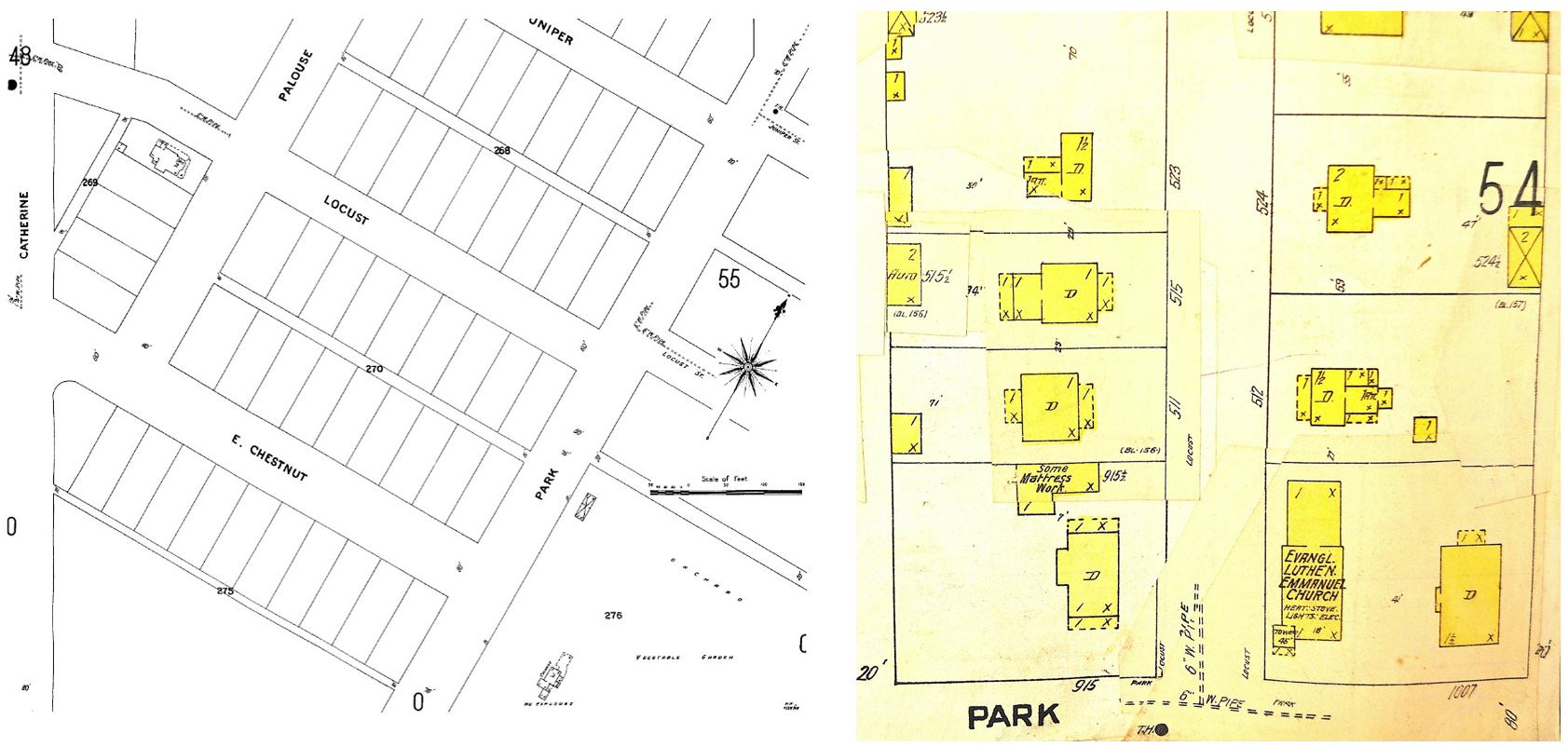
Left: the first edition of the 1905 Sanborn Fire Insurance Map shows nothing on Lots 1 and 2 of Block 7. Right: the 6/1929 update clearly shows Evangl. Luthen. Emmanual Church on the site, noting it is heated by stove, has lights and electricity, and shows the tower in the proper location.
Construction started on April 9, 1910 the corner-stone was laid for the new church, the building was completed in the fall [of 1910] and dedication followed.”
As noted in the above section, W. A. Pitcher sold Lots 1 and 2 to Emmaus Church on 10/31/1910 for $1,200. The cornerstone for the new building was placed on 4/9/1910, and the building was completed in late fall 1910.
By the late 1940s, the congregation of Emmaus Church had grown to the point that a new location was seen as necessary. The congregation adopted a resolution to look for a new location and building for the church, and in October 1950 they purchased the property at 109 South Roosevelt for $10,500. In January 1952 a Seattle architect was chosen to design a new church building, and that month Emmaus Church sold the building on Howard Street to a couple who were members of the Church of Jesus Christ of Latter Day Saints. The congregation determined that the new church would drop the Emmaus name and become Trinity Evangelical Lutheran Church. The church remains active to date.
In his 2013 report on the parsonage for Emmaus Evangelical Lutheran Church at 1007 Howard, Chris Baird wrote that in late 1953 or early 1954 Trinity Evangelical Lutheran Church split Lots 1 and 2 of Block 7 into two reconfigured lots, the old church building occupying the north half of each lot and the former parsonage occupying the south half of each lot.
The Fletchers sold the old Emmaus building to the Reorganized Church of Jesus Christ of Latter Day Saints, an Iowa Corporation on 1/5/1959, that continues to own the building. A sign attached to the gabled front porch roof reads Community of Christ, a name change made from the Reorganized LDS name in 2001. Community of Christ is described as a Restorationist faith expression with practices and beliefs in line with other mainstream Christian churches.
Resources
- TitleOne Title & Escrow (formerly Pioneer Title)
- Whitman College Archives
- Walla Walla City Directories, various years
- Walla Walla County Auditor’s online search
- Sanborn Fire Insurance Map, 1905 edition with updates
- Walla Walla Public Library
- Fiftieth Anniversary of Trinity Evangelical Lutheran Church, given to the congregation, 5/3/1959
- Wikipedia/Community of Christ
- Chris Baird, Webmaster, Walla Walla 2020

